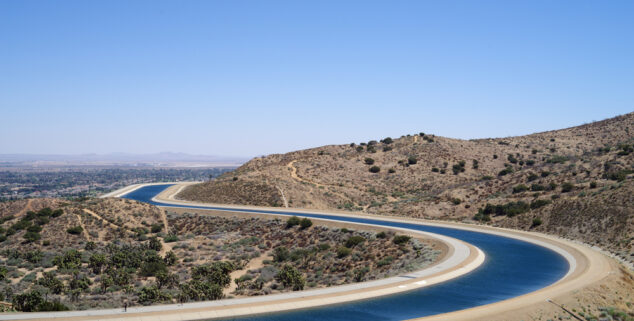Opinion
Prioritizing equity in statewide water management
 California Aqueduct near Palmdale. Image by Angel DiBilio
California Aqueduct near Palmdale. Image by Angel DiBilio OPINION – Climate change exacerbates California’s extreme wet and dry conditions, disrupting water delivery systems designed for historical seasonal precipitation patterns. As state and local water managers grapple with these challenges, the needs of Black, Brown, and disadvantaged communities cannot be ignored as it relates to access to water.
Where we see the greatest threat to disadvantaged communities is in water rates. One of the most affordable sources of water in the state comes from the State Water Project, which serves more than 27 million people, including 8 million disadvantaged community members spanning from the Bay Area to the border with Mexico and communities in between. Securing the reliability of the State Water Project is key to affordability.
Extreme weather whiplash is causing more severe swings between droughts and floods. Local water managers are doing what they can to build and expand local sources of water to weather these new precipitation patterns. While every community is different, there are excellent opportunities to save and develop water supplies through creative combinations of recycling, stormwater capture, groundwater banking, desalination, and conservation.
These projects have a place in regional portfolios. They also have a high price tag. These projects also aren’t scalable. The State Water Project provides millions of acre-feet a year and that water can’t just be replaced.
And yet the State Water Project is facing challenges that could render this source unreliable in the not-too-distant future. Not only from the effects of climate-driven weather extremes but also risks that earthquakes could drastically disrupt the water delivery system for up to a year or more, creating a significant economic and humanitarian crisis.
As state and local water managers grapple with these challenges, the needs of Black, Brown, and disadvantaged communities cannot be ignored as it relates to access to water.
Rather than continuing to put our faith entirely in our system of aging dirt levees, the Delta Conveyance Project adds an additional layer of security to guard against seismic risks. We are just a few months removed from a cluster of small quakes in the Delta, so the threat remains at the front of mind for many.
It is more important than ever to modernize water in the state’s infrastructure to take advantage of pockets of intense rain and momentary excess river flows and to fortify against seismic threats.
The Delta Conveyance Project would modernize the state’s water infrastructure to capture and move water during wet seasons to better endure dry seasons, minimize future losses from climate-driven weather extremes, and protect against earthquakes disrupting water supplies. Local water agencies have no easy task. They must prudently plan for the future to secure water supplies for families, businesses, and farms. At the same time, they must balance the cost of these plans and prioritize those that make the best business case.
As climate change casts a shadow of uncertainty, this question of affordability balanced with reliability looms squarely over the shoulders of disadvantaged communities who suffer a historic and disproportionate share of economic, health, and environmental burdens.
Many of the proposed alternatives to State Water Project water are not cost-effective for most Californians in Black, Brown, and disadvantaged communities. Throughout the state, water agencies have found that recycling, desalination, and other alternative supplies are two to three times more expensive than water from the SWP. With the cost of living continuing to skyrocket, decision-makers must be mindful of impacts to lower-income residents.
When it comes to equity and social justice, it is clear to us that affordability and water rates for disadvantaged communities must be prioritized and protected by stabilizing the State Water Project and building the Delta Conveyance Project. This is a true matter of Environmental Justice.
Rick L. Callender, Esq. is President of the NAACP California/Hawaii State Conference, which boasts 57 branches. From 2000 to 2008, Callender served as president of the
NAACP San Jose-Silicon Valley branch.
Want to see more stories like this? Sign up for The Roundup, the free daily newsletter about California politics from the editors of Capitol Weekly. Stay up to date on the news you need to know.
Sign up below, then look for a confirmation email in your inbox.

Leave a Reply